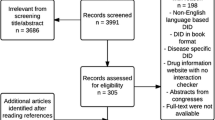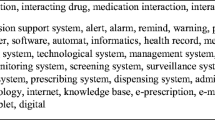Abstract
Background: Despite the availability and daily use of computerized drug-drug interaction surveillance systems, exposure to potentially relevant drug-drug interactions (DDIs) continues. DDI management guidelines are often inadequate and clear management options are lacking, which attributes to overriding of DDI signals. Although general criteria for the development and reporting of high-quality clinical practice guidelines have been identified, it appears these have not yet been applied to DDI management guidelines.
Objectives: The aim of the study was to assess the clarity and applicability of guidelines for the management of potentially harmful DDIs.
Methods: We selected 13 DDIs that are potentially harmful for patients and frequently occur in community pharmacy practice in the Netherlands. The clarity and applicability of the management guidelines of these DDIs were appraised using the appropriate two domains — ‘Clarity and presentation’ and ‘Applicability’, of the validated Appraisal of Guidelines for Research and Evaluation (AGREE) Instrument. The appraisal was performed by 12 community pharmacists and 12 general practitioners. The standardized domain scores and mean item scores for ‘Clarity and presentation’ and ‘Applicability’ were compared.
Results: All DDI management guidelines were generally found to score well on ‘Clarity and presentation’, but poorly with respect to ‘Applicability’ (standardized domain scores 68.0 vs 26.1%). Within the domain ‘Clarity and presentation’, the item ‘tools for application’ received the lowest scores. Within the domain ‘Applicability’, cost implications, organizational barriers and key review criteria were all poorly documented. All guidelines presented non-directive advice using words such as ‘consider’ and ‘regularly’.
Conclusions: Developers of DDI management guidelines should take the appropriate domains of the AGREE Instrument into consideration in their development processes. The applicability of DDI management guidelines should be pretested before publishing. To improve guideline quality, more attention should particularly be paid to the available tools for applications and cost implications.



Similar content being viewed by others
References
Juurlink DN, Mamdani M, Kopp A, et al. Drug-drug interactions among elderly patients hospitalized for drug toxicity. JAMA 2003 Apr 2; 289(13): 1652–8
Malone DC, Abarca J, Skrepnek GH, et al. Pharmacist workload and pharmacy characteristics associated with the dispensing of potentially clinically important drug-drug interactions. Med Care 2007 May; 45(5): 456–62
Merlo J, Liedholm H, Lindblad U, et al. Prescriptions with potential drug interactions dispensed at Swedish pharmacies in January 1999: cross sectional study. BMJ 2001 Aug 25; 323(7310): 427–8
Buurma H, De Smet P, Egberts A. Clinical risk management in Dutch community pharmacies: the case of drug-drug interactions. Drug Saf 2006; 29(8): 723–32
Van der Sijs H, Aarts J, Vulto A, et al. Overriding of drug safety alerts in computerized physician order entry. J Am Med Inform Assoc 2006 Mar–Apr; 13(2): 138–47
Weingart SN, Toth M, Sands DZ, et al. Physicians’ decisions to override computerized drug alerts in primary care. Arch Intern Med 2003 Nov 24; 163(21): 2625–31
Murphy JE, Forrey RA, Desiraju U. Community pharmacists’ responses to drug-drug interaction alerts. Am J Health Syst Pharm 2004 Jul 15; 61(14): 1484–7
Buurma H, de Smet P, van den Hoff O, et al. Nature, frequency and determinants of prescription modifications in Dutch community pharmacies. Br J Clin Pharmacol 2001 Jul; 52(1): 85–91
Abarca J, Colon LR, Wang VS, et al. Evaluation of the performance of drug-drug interaction screening software in community and hospital pharmacies. J Manag Care Pharm 2006 Jun; 12(5): 383–9
Becker M, Kallewaard M, Caspers P, et al. Potential determinants of drug-drug interaction associated dispensing in community pharmacies. Drug Saf 2005; 28(5): 371–8
Gaikwad R, Sketris I, Shepherd M, et al. Evaluation of accuracy of drug interaction alerts triggered by two electronic medical record systems in primary healthcare. Health Informatics J 2007 Sep; 13(3): 163–77
Indermitte J, Erba L, Beutler M, et al. Management of potential drug interactions in community pharmacies: a questionnaire-based survey in Switzerland. Eur J ClinPharmacol 2007 Mar; 63(3): 297–305
Bergk V, Gasse C, Schnell R, et al. Requirements for a successful implementation of drug interaction information systems in general practice: results of a questionnaire survey in Germany. Eur J Clin Pharmacol 2004 Oct; 60(8): 595–602
Hansten PD. Drug interaction management. Pharm World Sci 2003 Jun; 25(3): 94–7
Van Roon EN, Flikweert S, le Comte M, et al. Clinical relevance of drug-drug interactions: a structured assessment procedure. Drug Saf 2005; 28(12): 1131–9
Grol R, Dalhuijsen J, Thomas S, et al. Attributes of clinical guidelines that influence use of guidelines in general practice: observational study. BMJ 1998 Sep 26; 317(7162): 858–61
Grol R, Grimshaw J. From best evidence to best practice: effective implementation of change in patients’ care. Lancet 2003 Oct 11; 362(9391): 1225–30
Burgers JS, Grol RP, Zaat JO, et al. Characteristics of effective clinical guidelines for general practice. Br J Gen Pract 2003 Jan; 53(486): 15–9
Buurma H, Schalekamp T, Egberts AC, et al. Compliance with national guidelines for the management of drug-drug interactions in Dutch community pharmacies. Ann Pharmacother 2007 Dec; 41(12): 2024–31
The AGREE Collaboration. Development and validation of an international appraisal instrument for assessing the quality of clinical practice guidelines: the AGREE project. Qual Saf Health Care 2003 Feb; 12(1): 18–23
MacDermid JC, Brooks D, Solway S, et al. Reliability and validity of the AGREE instrument used by physical therapists in assessment of clinical practice guidelines. BMC Health Serv Res 2005 Mar 2; 5(1): 18
Gorman SK, Chung MH, Slavik RS, et al. A critical appraisal of the quality of critical care pharmacotherapy clinical practice guidelines and their strength of recommendations. Intensive Care Med 2010 Oct; 36(10): 1798–801
Burgers JS, Fervers B, Haugh M, et al. International assessment of the quality of clinical practice guidelines in oncology using the Appraisal of Guidelines and Research and Evaluation Instrument. J Clin Oncol 2004 May 15; 22(10): 2000–7
Wilting I, Egberts AC, Heerdink ER, et al. Evaluation of available treatment guidelines for the management of lithium intoxication. Ther Drug Monit 2009 Apr; 31(2): 247–60
Kinnunen-Amoroso M, Pasternack I, Mattila S, et al. Evaluation of the practice guidelines of Finnish Institute of Occupational Health with AGREE instrument. Ind Health 2009 Dec; 47(6): 689–93
McNair RP, Hegarty K. Guidelines for the primary care of lesbian, gay, and bisexual people: a systematic review. Ann Fam Med 2010 Nov–Dec; 8(6): 533–41
Faggion Jr CM. Clinician assessment of guidelines that support common dental procedures. J Evid Based Dent Pract 2008 Mar; 8(1): 1–7
Van Diermen DE, Aartman IH, Baart JA, et al. Dental management of patients using antithrombotic drugs: critical appraisal of existing guidelines. Oral Surg Oral Med Oral Pathol Oral Radiol Endod 2009 May; 107(5): 616–24
Potting C, Mistiaen P, Poot E, et al. A review of quality assessment of the methodology used in guidelines and systematic reviews on oral mucositis. J Clin Nurs 2009 Jan; 18(1): 3–12
Royal Dutch Association for the Advancement of Pharmacy. The G-standard: structure, safety assessment and decision support [online]. Available from URL: http://www.knmp.nl/vakinhoud/farmacotherapie/g-standaard/the-g-standaard-the-medicines-standard-in-healthcare [Accessed 2008 Dec 10]
Medication surveillance commentaries 2008–2009 [in Dutch]. Houten: Health Base Foundation, 2008
Guyatt GH, Oxman AD, Vist GE, et al. GRADE: an emerging consensus on rating quality of evidence and strength of recommendations. BMJ 2008 Apr 26; 336(7650): 924–6
Guyatt GH, Cook DJ, Jaeschke R, et al. Grades of recommendation for antithrombotic agents: American College of Chest Physicians Evidence-Based Clinical Practice Guidelines (8th ed.). Chest 2008 Jun; 133 (6 Suppl.): 123–31S
Nuckols TK, Lim YW, Wynn BO, et al. Rigorous development does not ensure that guidelines are acceptable to a panel of knowledgeable providers. J Gen Intern Med 2008 Jan; 23(1): 37–44
Ray-Coquard I, Philip T, de Laroche G, et al. A controlled “before-after” study: impact of a clinical guidelines programme and regional cancer network organization on medical practice. Br J Cancer 2002 Feb 1; 86(3): 313–21
Shrout PE, Fleiss JL. Intraclass correlations: uses in assessing rater reliability. Psychol Bull 1979 Mar; 86(2): 420–8
Burgers JS. Guideline quality and guideline content: are they related? Clin Chem 2006 Jan; 52(1): 3–4
Watine J, Friedberg B, Nagy E, et al. Conflict between guideline methodologic quality and recommendation validity: a potential problem for practitioners. Clin Chem 2006 Jan; 52(1): 65–72
Acknowledgements
We would very much like to thank all general practitioners and community pharmacists who participated in this study. Special thanks to Jan Mulder and Svetlana Belitzer for their advice on the statistical analysis of the data.
No sources of funding were used to conduct this study or prepare this manuscript. The authors have no conflicts of interest that are directly relevant to the content of this study. All authors met the criteria for authorship, and read and approved the final version of the manuscript.
Author information
Authors and Affiliations
Corresponding author
Rights and permissions
About this article
Cite this article
Floor-Schreudering, A., De Smet, P.A.G.M., Buurma, H. et al. Clarity and Applicability of Drug-Drug Interaction Management Guidelines. Drug-Safety 34, 683–690 (2011). https://doi.org/10.2165/11587270-000000000-00000
Published:
Issue Date:
DOI: https://doi.org/10.2165/11587270-000000000-00000




